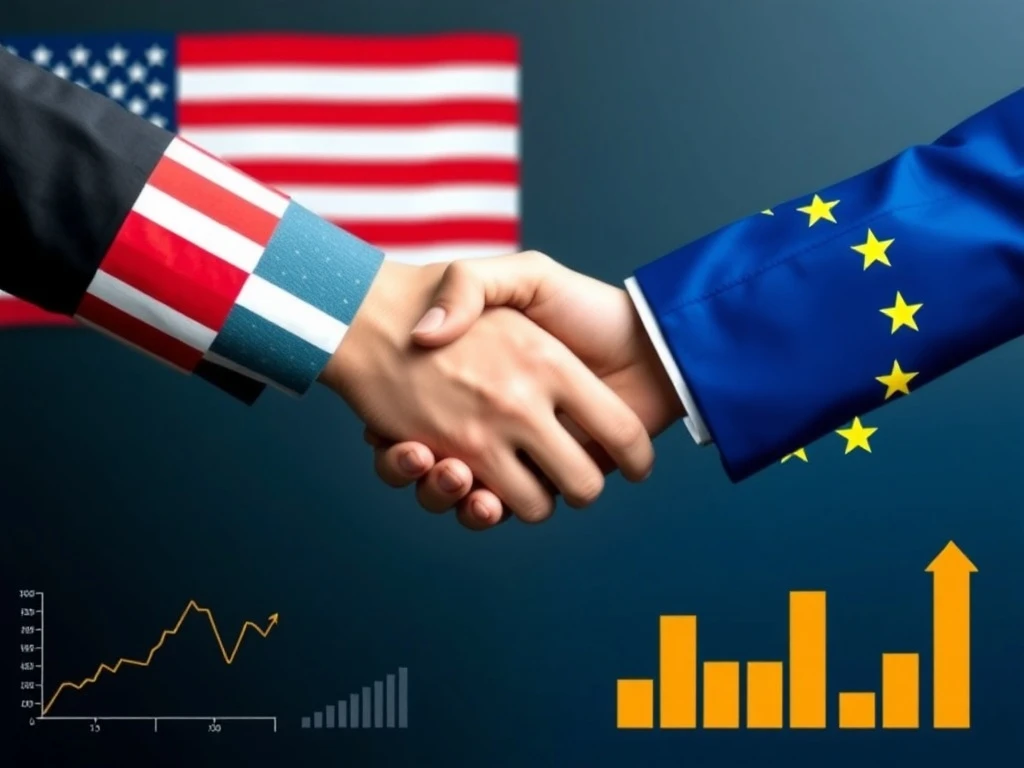US-EU Trade Deal: Historic Agreement Averts Tariff Crisis, Unlocks Trillions in Global Trade

In a world increasingly shaped by interconnected economies, major geopolitical shifts often ripple through financial markets, including the dynamic cryptocurrency space. The recent US-EU Trade Deal represents one such monumental development, promising to reshape international commerce and potentially influence market sentiment. On July 27, 2025, the United States and the European Union announced a landmark agreement that could redefine their economic relationship for years to come. This deal, setting a 15% tariff rate on most EU imports to the U.S. and committing to hundreds of billions in cross-border investments, is a critical step in de-escalating trade tensions and fostering a more predictable global economic environment.
What Does the Landmark US-EU Trade Deal Entail?
The core of the newly minted US-EU Trade Deal revolves around a crucial compromise: a 15% tariff rate on the majority of goods imported from the European Union into the United States. This rate is a significant reduction from the impending 30% tariff increase that was set to take effect on August 1, which would have seen U.S. duties on EU exports jump from 10% to 30%. President Donald Trump confirmed the deal following intense negotiations in Scotland, highlighting its importance in avoiding a potentially damaging trade war.
Beyond tariffs, the agreement lays out an ambitious framework for substantial economic collaboration. Key commitments include:
- EU Investment in U.S. Industries: A pledge of $600 billion from the EU to be invested in various U.S. industries. This massive inflow of capital is expected to stimulate job creation and technological advancement across the United States.
- EU Purchases of U.S. Energy Products: The EU has committed to purchasing $750 billion in U.S. energy products, a move that significantly boosts American energy exports and strengthens energy security for Europe.
- U.S. Tariff Reductions: The U.S. will reciprocate by reducing tariffs on certain sectors, notably aircraft and spirits, providing relief and greater market access for European producers in these areas.
While the deal aims for broad coverage, certain strategic sectors have been given specific consideration. President Trump clarified that pharmaceuticals and metals would not be subject to the new 15% rate, maintaining existing arrangements for these critical industries. However, autos, a highly sensitive sector for both economies, are confirmed to be included in the 15% tariff structure, marking a notable shift from the previous 25% tariff on European cars.
How Did This Tariff Agreement Avert a Major Economic Crisis?
The primary achievement of this Tariff Agreement is the successful avoidance of a dramatic escalation in trade tensions. Had the planned 30% tariffs gone into effect, it would have significantly increased the cost of European goods for American consumers and businesses, potentially stifling economic growth and triggering retaliatory measures from the EU. Such a scenario could have led to a full-blown trade war, with far-reaching negative consequences for global supply chains, investment, and market stability.
For the EU, this agreement represents a calculated compromise. While the reduction of auto tariffs from 25% to 15% is a welcome relief for major European automakers, existing 50% tariffs on steel and aluminum remain in place. EU diplomats described the 15% rate as “all inclusive” for most goods, yet acknowledged exceptions for specific strategic industries. Market analysts, such as Michael Brown, a senior research strategist at Pepperstone, lauded the deal for removing a key “left tail risk” for global markets. This suggests that the agreement has alleviated a significant downside risk, fostering a sense of greater predictability and reinforcing a global trend toward negotiated trade agreements rather than confrontational rhetoric.
What Does Cross-Border Investment Mean for Future Growth?
The pledges of substantial Cross-Border Investment are perhaps the most forward-looking aspect of this agreement. The EU’s commitment to invest $600 billion in U.S. industries and purchase $750 billion in U.S. energy products signals a deep and long-term economic alignment. This mirrors a similar U.S.-Japan trade agreement from earlier in July, which also set a 15% tariff and secured a $550 billion investment pledge from Japan. These commitments underscore a broader strategy by the U.S. administration to leverage trade negotiations to secure not just tariff reductions but also significant investment and energy security deals.
Treasury Secretary Scott Bessent highlighted that Japan’s investment offer was instrumental in clinching the deal with the EU, suggesting a strategic link between these bilateral agreements. However, skepticism persists among some Wall Street analysts regarding the EU’s practical ability to deliver on the promised funds. The scale of these investment commitments is unprecedented and will require significant coordination and political will from both sides to materialize fully. If successful, these investments could:
- Spur innovation and technological development in key U.S. sectors.
- Create new jobs and boost economic output.
- Strengthen the long-term economic ties between the U.S. and the EU.
- Provide the EU with a stable and diverse energy supply.
What Are the Broader Implications for Global Trade?
Valued at an impressive $1.9 trillion annually in goods and services, this Global Trade agreement between the U.S. and the EU is one of the largest bilateral deals in recent history. Its implications extend far beyond the immediate economic benefits for the two parties involved. For instance, European automakers stand to gain immediately from reduced tariffs, making their products more competitive in the U.S. market. Similarly, U.S. defense and energy firms are poised to benefit substantially from the EU’s investment and purchase commitments.
However, the agreement also highlights ongoing complexities in international trade. While the EU energy and steel sectors secured limited quotas and a carve-out for liquefied natural gas purchases, the deal also includes vague commitments on U.S. defense sales, with President Trump suggesting “vast amounts” of American weapons would be part of the agreement. This suggests that trade deals are increasingly intertwined with broader geopolitical and security considerations.
The successful conclusion of this deal also sends a strong signal to other trading partners. While the U.S. and EU have averted a trade war for now, other crucial negotiations loom. The U.S. and China, for instance, are set to begin talks on August 12, with no extensions offered for resolving disputes with other trading partners. This indicates a continued assertive approach by the U.S. in reshaping global trade dynamics.
Can This Deal Ensure Long-Term Economic Stability?
While the immediate relief provided by the Economic Stability of this deal is palpable, uncertainties persist that could test its durability. The EU maintains a contingency plan to impose retaliatory tariffs on $109 billion of U.S. goods if the agreement collapses, serving as a significant deterrent against any unilateral U.S. actions. Furthermore, France has advocated for invoking a “trade bazooka” to counter perceived coercive practices, though such measures would undoubtedly escalate tensions and undermine the spirit of cooperation.
Another significant sticking point remains the finalization of details for the auto sector. Despite being included in the 15% tariff, its economic significance to EU members like Germany and France means that specific terms and quotas will be crucial for the deal’s long-term acceptance and success. The EU’s ability to balance its diverse industrial interests with U.S. demands will be a key test of the deal’s resilience.
Ultimately, this agreement aligns with President Trump’s broader strategy of leveraging tariffs to secure investment and energy commitments, shifting the paradigm of international trade negotiations. Its success will depend on continued political will, transparent implementation, and the ability of both sides to navigate future disagreements without resorting to protectionist measures. For global markets, including the volatile cryptocurrency space, such large-scale macroeconomic shifts can influence investor confidence and capital flows, making stable trade relations a foundational element for broader market health.
In conclusion, the U.S.-EU tariff deal is a monumental step towards de-escalating trade tensions and fostering deeper economic ties. By averting a 30% tariff hike and securing massive investment and energy commitments, it provides immediate relief and sets a framework for future growth. While challenges remain, particularly in finalizing specific sector details and ensuring the delivery of investment pledges, the agreement signals a shift towards negotiated solutions over confrontation, offering a beacon of stability in an often unpredictable global economic landscape. Its success will be closely watched, not just by governments and industries, but by markets worldwide, as it sets a precedent for how major economic powers can resolve disputes and unlock mutual prosperity.
Frequently Asked Questions (FAQs)
1. What is the core of the US-EU tariff deal announced on July 27, 2025?
The core of the US-EU Trade Deal is a new 15% tariff rate on most EU imports to the U.S., which notably averts a planned 30% tariff increase. It also includes commitments for the EU to invest $600 billion in U.S. industries and purchase $750 billion in U.S. energy products, while the U.S. reduces tariffs on sectors like aircraft and spirits.
2. How does this Tariff Agreement benefit both the U.S. and the EU?
For the U.S., it secures significant Cross-Border Investment and energy purchases, boosting American industries and exports. For the EU, it prevents a potentially damaging 30% tariff hike, reduces tariffs on autos from 25% to 15%, and provides greater market predictability, benefiting European exporters and overall Global Trade stability.
3. What are the main challenges or uncertainties surrounding this deal?
Key challenges include the EU’s contingency plan for retaliatory tariffs if the deal collapses, France’s advocacy for aggressive trade measures, the need to finalize specific details for the economically significant auto sector, and skepticism among some analysts regarding the EU’s ability to fully deliver on its investment pledges. These factors could impact the deal’s long-term Economic Stability.
4. How does this agreement compare to other recent trade deals?
This deal mirrors the U.S.-Japan trade agreement signed earlier in July, which also set a 15% tariff and secured a $550 billion investment pledge from Japan. Both agreements align with the U.S. strategy of leveraging tariffs to secure broader investment and energy commitments from trading partners.
5. What is the overall estimated value of this trade agreement?
The agreement is estimated to be valued at $1.9 trillion annually in goods and services, making it one of the largest and most impactful bilateral trade deals in recent history.
6. How might this impact global financial markets, including cryptocurrency?
Major macroeconomic shifts like this trade deal can significantly influence investor confidence and capital flows. By averting a trade war and fostering greater economic predictability, it contributes to overall market stability, which can indirectly impact the broader financial landscape, including the performance and sentiment in cryptocurrency markets.









